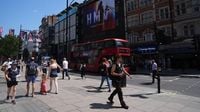British retail sales saw a notable uptick in July 2025, fueled by a rare convergence of sunny weather and the excitement generated by the UEFA Women’s Euro 2025 football tournament. According to the Office for National Statistics (ONS), retail sales volumes rose by 0.6% compared to June, a result that outpaced economists’ forecasts of a modest 0.2% rise. The ONS also reported that annual retail sales growth reached 1.1% for July, though this figure fell short of market expectations and was dampened by downward revisions to previous months’ data (Reuters, Investing.com, BBC).
The boost in July was especially pronounced for clothing, footwear, and online retailers. As Danni Hewson, head of financial analysis at AJ Bell, explained to BBC, “With long spells of sunshine and rising temperatures, many of us were tempted to splash out on new summer lines, updating wardrobes with flowing dresses or smart shorts that would be acceptable as office attire.” The surge in apparel sales was echoed by online retailers, who also reported strong growth. Deann Evans, a senior executive at Shopify, told The Guardian that sales of school uniforms soared by almost 500% month-on-month in July as families prepared for the new school year.
But this summer’s sales jump wasn’t just about fashion. Currys, a leading electronics retailer, noted a spike in demand for air conditioners and fans, a trend attributed to “unbearably hot nights” (BBC, Reuters). The company reported a 3% increase in sales across Britain and Ireland over the four months ending in August, underscoring how the weather can directly sway consumer habits.
Yet, beneath the surface, the story of British retail is more complicated. The ONS’s handling of the data itself became a headline, after the agency delayed the release of July’s figures by two weeks due to errors in seasonal adjustments. As reported by The Guardian and BBC, the ONS admitted to mistakes in how it accounted for holidays and collection periods, leading to overstatements of monthly volatility earlier in the year. The revised data painted a less volatile, but still modest, growth picture.
James Benford, the ONS’s incoming director general for economic statistics, offered a candid apology: “I apologise for the delay to this release, and for the errors in how we have been seasonally adjusting these data.” He emphasized that the agency is prioritizing improvements to its economic statistics and transparency. “Our annual review of how we adjust for seasonality found that we had not adjusted figures correctly. This resulted in our previous figures overstating the monthly volatility in retail sales in the first half of the year.”
The ONS’s credibility has faced mounting scrutiny in recent months, with a government report in June criticizing its management culture and performance, particularly regarding labor force and retail data. As a result, the agency is now under pressure to restore confidence ahead of the autumn budget, which is scheduled for late November (Reuters, The Guardian).
Digging deeper into the numbers, the ONS revealed that sales volumes in the three months to July were actually down 0.6% compared with the previous three months—a sobering reminder that July’s boost was largely a one-off. Paul Dales, chief UK economist at Capital Economics, told Reuters, “The retail sales figures are a bit softer than they look.” He cautioned that the July jump was driven by temporary factors such as the weather and the football tournament, both unlikely to be repeated soon.
Food purchases, meanwhile, slipped by 0.2% in July, and department store sales fell by 1.5%. This was offset by a robust 2.5% increase in clothing and footwear sales, as well as a matching 2.5% rise in online and mail-order retailing (Reuters). The British Retail Consortium reported that while spending at major retail chains grew by 2.5% in cash terms in July, higher prices meant that actual purchase volumes fell.
Supermarkets, sports shops, and household goods stores had enjoyed a strong start to the year, but spending there has tailed off since March, the ONS noted. Dr. Kris Hamer, director of insight at the British Retail Consortium, remarked, “July was a good month for retail sales, as the warm, sunny weather and packed sporting schedule in the first half of the month got people spending, especially for alcoholic beverages as people came together.” Yet, he pointed out, this uptick does little to offset the £7 billion in new costs retailers face following last year’s Budget. Hamer warned, “Government must ensure that no additional tax is levied onto retailers, or else many will be forced to make difficult decisions around raising prices, store closures, and jobs.”
Inflation remains a persistent concern. Consumer price inflation rose to 3.8% in July and is expected to climb to 4% by September, according to Bank of England projections (Reuters). Food and drink prices, in particular, jumped by almost 5% compared to July 2024, leading shoppers to put fewer items in their baskets and exercise greater caution across other categories (PwC, British Retail Consortium). Kien Tan, Senior Retail Adviser at PwC, observed, “It’s clear that the momentum in retail spending is slowing, with sales in the second quarter of 2025 below that of the first quarter by 0.6% in volume terms and by 0.2% on a cash basis.”
Despite a slight improvement in consumer sentiment in July, as measured by PwC, the overall trend remains subdued. Retail sales volumes have now been below pre-pandemic levels for three years, reflecting a consumer base still wary amid rising living costs, softer earnings growth, and tighter fiscal policy. Matt Swannell, chief economic adviser to EY ITEM Club, told BBC, “Households seem likely to shed some of the significant caution that has characterised the past couple of years. However, softer earnings growth, higher inflation, tighter fiscal policy, and the lagged impact of past interest rate rises for some mortgagors point to much weaker real income growth moving forward.”
Meanwhile, the housing market offered a glimmer of optimism, with British house prices rising by 0.3% in August—the third consecutive monthly increase—leaving prices 2.2% higher than a year earlier, according to Halifax. These gains surpassed economists’ expectations and suggest some underlying resilience in consumer confidence (Investing.com).
As the critical Christmas season approaches, retailers are bracing for further headwinds. Many hope that inflation will not sap shoppers’ willingness to spend, while also anxiously watching for any new tax measures in the upcoming Budget. The July sales surge, while welcome, may prove fleeting—a bright spot in an otherwise challenging retail landscape.


